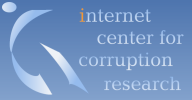
| Home → Corruption Perceptions Index → Older Indices → Background information |  |
| Home | |||
| Contact information | |||
| Research Area | |||
| Corruption Perceptions Index | |||
| 2009 and later | 2008 | 2007 | |
| 2006 | |||
| 2005 | |||
| 2004 | |||
| 2003 | |||
| 2002 | |||
| 2001 | |||
| 2000 | |||
| older indices | |||
| childhood days | |||
| Lecture and Workshops |
The Transparency International Bribe Payers Index (BPI) ranks the leading exporting countries in terms of the degree to which their companies are perceived to be paying bribes abroad.
The BPI is the result of a special international survey conducted for Transparency International by the Gallup International Association in 14 leading emerging market economies.
The BPI was first published in 1999.
The TI Corruption Perceptions Index (CPI) ranks countries in terms of the degree to which corruption is perceived to exist among public officials and politicians.
The 1999 CPI ranks 99 countries. It is a composite index, drawing on 17 different polls and surveys from 10 independent institutions carried out among business people, the general public and country analysts.
Transparency International focuses on corruption in the public sector and defines corruption as the abuse of public office for private gain. The surveys used in compiling both indices tend to ask questions in line with the misuse of public power for private benefits, with a focus, for example, on bribing of public officials or giving and taking of kickbacks in public procurement.
Absolutely not. Transparency International bends over backwards to convince journalists and others that this is a false interpretation. Why? First, there are over 200 sovereign nations in the world and the CPI can only rank 99, because we just do not have sufficient good data for all countries. Second, the CPI is based on polls, which are snapshots in time and solely reflect opinions.
The CPI has been published for the past five years. It has been important in raising public awareness and in shattering the taboo that surrounds corruption. In a number of countries it has spurred the introduction of wide-ranging reform efforts. However, the CPI only points the finger at the recipients of bribery. TI has always felt that this was inadequate, particularly since it does not reflect the responsibility of exporting countries for international corruption. The 1999 BPI is the first attempt to address this.
The single most important reason is that the 1999 ratification of the OECD Anti-Bribery Convention means that most of the leading industrial countries are committed to taking action to stop transnational corporations in their countries from paying bribes abroad. TI wants to bring to public attention the need for full implementation and enforcement of the new convention. The 1999 BPI therefore provides a baseline to assess the successful implementation of the convention.
Yes. It is impossible to base comparative statements on the levels of corruption in different countries on hard empirical data, e.g. by comparing the number of prosecutions or court cases. Such cross-country data commonly do not reflect actual levels of corruption but the quality of prosecutors, courts or the media in exposing corruption. The only method of compiling comparative data therefore is to build on the experience and perceptions of those most directly confronted with the realities of corruption, e.g. business people, country experts, chambers of commerce etc.
Polls are very useful, especially when it is not possible to obtain empirical factual evidence. TI's concerns have been to ensure that the polling organisations used are of the highest reputation, that the survey work is done with full integrity and that the methodologies used to analyse the survey findings are first class. TI is confident that these criteria apply to the CPI and the BPI. The BPI is brand new and TI is keen to learn from this first set of data and to move ahead to strengthen its work in this area.